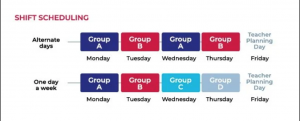The reality of schooling in America looks vastly different than it did at the beginning of last school year. COVID-19 has ravaged communities and put a strain on each of our students, educators, and their families. As the beginning of the 2020-2021 school year draws nearer–only 2 weeks away for some Alabama students–district leaders are making many difficult decisions about how to proceed, and more are deciding to forego in-person instruction for the beginning of the year.
The safety, health, and wellbeing of our students and teachers is of the utmost importance, and these decisions are not easy. Local districts have to balance factors like the rate of new COVID-19 cases, the needs of working parents, the academic and social-emotional needs of students, and many other factors to determine the most appropriate course. Additionally, there are serious concerns about the loss of high-quality instruction and its effect on our underserved students.
Already, research suggests that a shift from in-person to fully remote schooling can negatively impact student learning. Research from McKinsey & Company shows that the average student in a full-time remote environment can fall 7 months behind academically, while black students and hispanic students experience a 10 and 9 month loss respectively. Poor students can experience a loss of over a year. Researchers estimate these losses would widen the achievement gap by 15-20%.
Not All Remote Learning is Created Equal
Fully remote options are appropriate for some students, particularly those with health risks, and parents should be able to make the decision that is best for their families. It is critical that these remote options are high quality. National data from the end of last school year shows a stark contrast between the type and quality of instruction offered to white, suburban, and/or affluent students and their black, rural, and/or economically-disadvantaged peers.
According to The Center for Reinventing Public Education, wealthy districts were twice as likely to offer high quality live remote learning than poor districts. Wealthy districts were also significantly more likely to track attendance and engagement during virtual learning sessions. Only 14.5% of school districts with the highest concentration of poverty expected teachers to provide live instruction. Alternatively, only 27% of rural districts in the U.S. even required any instruction at all. It’s estimated that two thirds of all districts nationwide set low expectations for sustaining instruction.
Understanding that remote learning will continue in some capacity until virus spread slows, it is critical that schools provide access to a digital environment that offers rigorous curriculum through high quality blended and personalized instruction. This article provides several strategies to support such an approach. On-going teacher professional development will be a critical ingredient to success.
Hybrid Instruction May Help Slow the Slide
As we move toward a return to traditional school when it is safe, a hybrid approach may help bridge the gap. Data tells us that students who struggle with in-person classes are even more likely to struggle in a remote environment. For example, The American Institute for Research and the University of Chicago Consortium on School Research found algebra test scores were lower in a remote vs. traditional setting. Students assigned to the remote option also rated the class more difficult.
Understanding this reality, many schools across the country are choosing hybrid models of instruction to address the needs of students, until they can return to traditional school. As referenced in this article from Education Week, limited in-person instruction gives districts the opportunity to reach students who need more support, such as those in special education, English-language learners, or younger students, where remote instruction is more difficult. Districts are able to customize schedules to meet their needs and adapt to specific challenges based on research and community feedback.
Here are some examples of how hybrid schedules might look for schools:
- A “Split Schedule” in which students are divided into groups, and each group attends schools on designated days as shown below. This would also provide opportunities to offer professional development for teachers and families via remote learning on a weekly basis. A few local school districts in Alabama are choosing options similar to this format.

From Education Week
- A “Split Day” Schedule where half of the students would attend in the morning and the other half would attend in the afternoon everyday.
- Holding in-person instruction for elementary school students, and conducting remote learning for middle and high school students.
Show Me the Resources
Entering the Fall, equitable access to quality instructional and technical resources is paramount. Students who attend well-resourced schools often have access to resources that their disadvantaged peers do not. Access to digital devices, an adequate broadband connection, high-quality instruction, and teachers with high-quality training for virtual instruction are just a few examples. For context, only about 30% of residents in 9 of Alabama’s most rural counties have access to broadband internet. To begin addressing this disparity, Governor Ivey has awarded $18.5 million in broadband grants this year. Additionally, the Governor committed $170 million in digital learning and healthcare support to local districts this week. These investments, when implemented, could begin to fill persistent resource gaps.
As we navigate this new reality of schooling, we must utilize this opportunity to reimagine schools and innovate our practices to better serve all students, especially students of color and students in poverty. Flexibility and equitable allocation of resources and greater investments to support high-quality instruction will be required to chart this new course. Our end goal must be to reinvent a high quality education system that works for all students, regardless of their circumstances.

0 Comments on "Schools Reopen: Overcoming the Equity Challenges of COVID-19"